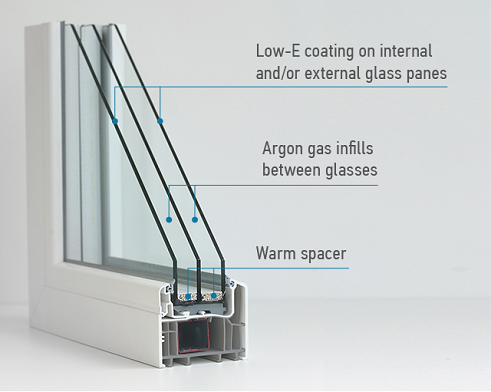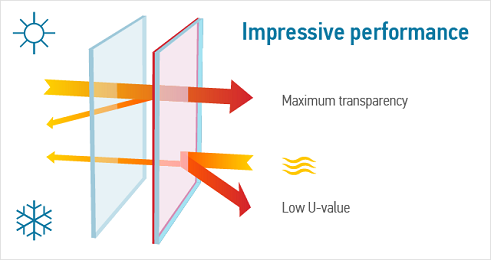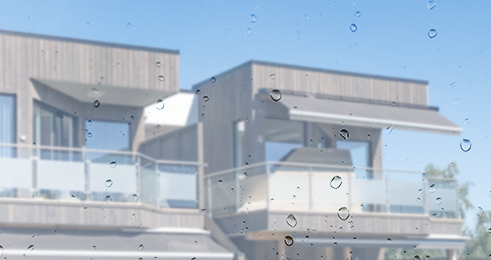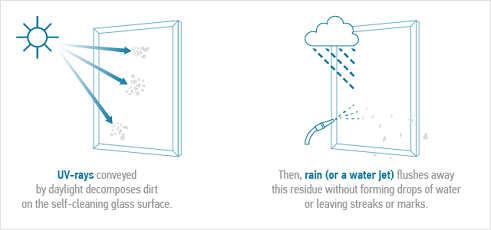Since the invention of a glass unit, thermal insulation properties can be improved mainly in three ways protecting heat loss by radiation, convection and conduction:
- Special internal coatings on the glass surface “Low-E” provide up to 9 times better thermal insulation and heat loss by radiation is reduced. In short, invisible “Low-E” coating is reflecting the heat and keeps it inside of the building.
- Inert gas infills between glass panes: argon, krypton or xenon. Dense argon gas reduces the amount of heat lost by convection, since it doesn’t move or rotate and has less moisture than air. Being around 35% less conductive than regular air, argon can increase the energy efficiency of a window by anything up to 30%. Argon is considered as the standard for glass units and most cost and energy efficient compared to krypton or xenon, that are denser, but though significantly stepping up in price terms than argon.
- A weak point in the construction of a glass unit, in terms of thermal insulation, is a metal (usually aluminum) spacer between glass panes, which is a very good conductor of heat. Mostly it’s because the temperature of the metal spacer is lower than the central part of the glass unit, which can lead to the condensation of these areas – the so-called cold bridge. This problem is solved by replacing the aluminium spacer with a special “warm” one out of materials that conduction of the heat is very low: plastic combined with stainless steel foil. With warm spacers the heat loss is reduced by approx. 5% and possibility of condensation is significantly reduced.
No matter the best thermal insulation is achieved by using Low-E on glass panes, argon and warm spacer (expressed by low Ug value), glass unit with this configuration will not cope with overheating the premises during summer heats and will not protect from harmful UV rays, that make the surfaces fade, when window is exposed by direct sun. In these cases, investment in sun control glass will make a significant return, as glass units with low Ug value and sun control will provide protection against heat loss in winter and will also reduce the costs of air conditioning in the summer.
Wide range of sun control glass types allows to choose desirable characteristics of the light entering through the window and the main indicators are:
- Light transmission (LT) – the percentage of visible light that is transmitted through the glass. The higher the percentage the more daylight.
- Visible Light Reflection (LR). The percentage of visible light that is reflected by the glass surface. The higher the percentage the more reflection.
- Solar factor or solar heat gain (TST or g). The measure of the total solar energy transmittance entering a building through the glazing as heat gain. The lower the “g” factor, the better the glass restricts heat energy transmission.
Sound reduction
Sound reduction glass units reduce the external noises caused by traffic, construction works, and other ones caused from environment. Sound intensity is measured by decibels (dB) and sound proofing index (Rw) defines the difference between the intensity of sound in interior and exterior. The lower window resonance frequency the better sound proofing properties.
Aspects that affect sound insulation in the glass unit:
- Glass mass. The thicker the glass panes, the better sound insulation.
- Configuration of the glasses in the unit. Different thickness glass panes will reduce the transmittance of the noise, eg, by using 6 and 4 mm in the same unit.
- Special glasses laminated with sound proofing films. In addition, provide safety during accident glass brake.
uPVC profile systems have multiple chambers inside the profile structure while the hardware system is equipped with multi-point locking system to ensure proper closing and tightness. This efficiently also reduces noise disturbance down. The minimum sound insulation is 34 dB and it can reach as high as 47 dB.
Self cleaning glass – the ideal solution for saving time
Maintenance of household takes surprisingly lots of efforts and time. While enjoying generous light that large windows or facades provide, we are less keen when it comes to cleaning. Studies show 74% of private individuals, cleaning windows glass consider as no menial task.
What is self-cleaning glass and how does it work?
Thanks to a special transparent coating embedded into its outer surface, the glass stays cleaner, longer, playing on daylight’s ultraviolet rays which decompose organic pollutants, and on the rain which then flushes them away, 100% naturally. This coating also avoids streaks formed by water drops, making cleaning easier.
Benefits:
- Time-saving: faster cleaning, less frequently.
- Easy-to-clean: less dirt accumulates.
- Ideal for hard-to-reach places: pitched conservatory roofs and skylights.
- Better transparency: clearer view when it’s raining, and outside condensation disappears faster.
- Environmentally friendly: no detergent required.
- Financial gain: save on cleaning costs.
Read more about SELF CLEANING GLASS: http://ventawindows.newsletter-send7.com/email/SELF-CLEANING-GLASS-425027




